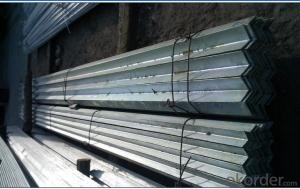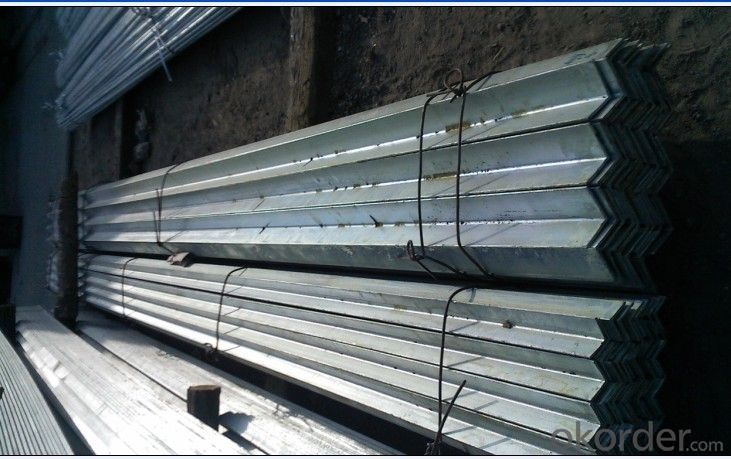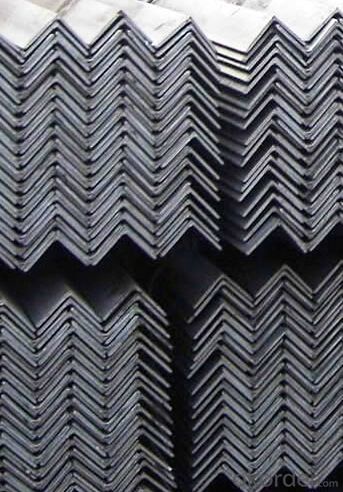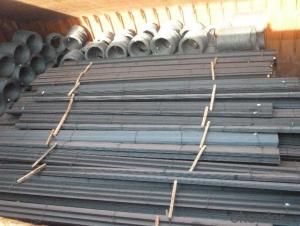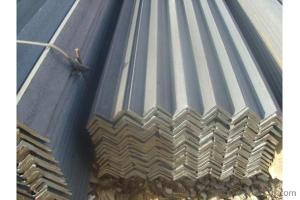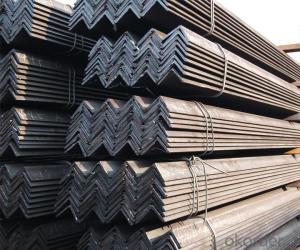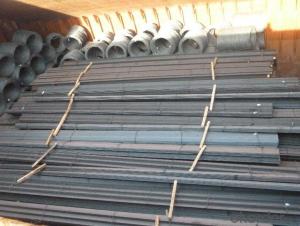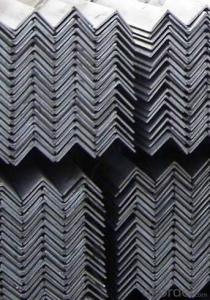Hot Rolled Steel Unequal Angle Bars
- Loading Port:
- Tianjin
- Payment Terms:
- TT or LC
- Min Order Qty:
- 100 m.t.
- Supply Capability:
- 20000 m.t./month
OKorder Service Pledge
OKorder Financial Service
You Might Also Like
OKorder is offering Hot Rolled Steel Unequal Angle Bars at great prices with worldwide shipping. Our supplier is a world-class manufacturer of steel, with our products utilized the world over. OKorder annually supplies products to African, South American and Asian markets. We provide quotations within 24 hours of receiving an inquiry and guarantee competitive prices.
Product Applications:
Hot Rolled Steel Unequal Angle Bars are ideal for structural applications and are widely used in the construction of buildings and bridges, and the manufacturing, petrochemical, and transportation industries
Product Advantages:
OKorder's Hot Rolled Steel Unequal Angle Bars are durable, strong, and wide variety of sizes.
Main Product Features:
· Premium quality
· Prompt delivery & seaworthy packing (30 days after receiving deposit)
· Can be recycled and reused
· Mill test certification
· Professional Service
· Competitive pricing
Product Specifications:
Manufacture: Hot rolled
Grade: Q195 – 235
Certificates: ISO, SGS, BV, CIQ
Length: 6m – 12m, as per customer request
Packaging: Export packing, nude packing, bundled
| UNEQUAL ANGLE STEEL | |||||
| size(mm) | a(mm) | a1(mm) | thickness(mm) | kg/m | length(m) |
| 75*50*5 | 75 | 50 | 5 | 4.808 | 6m,9m,12m |
| 75*50*6 | 75 | 50 | 6 | 5.699 | 6m,9m,12m |
| 75*50*8 | 75 | 50 | 8 | 7.431 | 6m,9m,12m |
| 100*75*7 | 100 | 75 | 7 | 9.34 | 6m,9m,12m |
| 100*75*8 | 100 | 75 | 8 | 10.6 | 6m,9m,12m |
| 100*75*9 | 100 | 75 | 9 | 11.8 | 6m,9m,12m |
| 100*75*10 | 100 | 75 | 10 | 13 | 6m,9m,12m |
| 100*75*12 | 100 | 75 | 12 | 15.4 | 6m,9m,12m |
| 125*75*7 | 125 | 75 | 7 | 10.7 | 6m,9m,12m |
| 125*75*8 | 125 | 75 | 8 | 12.2 | 6m,9m,12m |
| 125*75*9 | 125 | 75 | 9 | 13.6 | 6m,9m,12m |
| 125*75*10 | 125 | 75 | 10 | 15 | 6m,9m,12m |
| 125*75*12 | 125 | 75 | 12 | 17.8 | 6m,9m,12m |
| 150*90*8 | 150 | 90 | 8 | 14.7 | 6m,9m,12m |
| 150*90*9 | 150 | 90 | 9 | 16.4 | 6m,9m,12m |
| 150*90*10 | 150 | 90 | 10 | 18.2 | 6m,9m,12m |
| 150*90*12 | 150 | 90 | 12 | 21.6 | 6m,9m,12m |
| 200*100*10 | 200 | 100 | 10 | 23 | 6m,9m,12m |
| 200*100*12 | 200 | 100 | 12 | 27.62 | 6m,9m,12m |
| 200*100*15 | 200 | 100 | 15 | 34.04 | 6m,9m,12m |
FAQ:
Q1: Why buy Materials & Equipment from OKorder.com?
A1: All products offered byOKorder.com are carefully selected from China's most reliable manufacturing enterprises. Through its ISO certifications, OKorder.com adheres to the highest standards and a commitment to supply chain safety and customer satisfaction.
Q2: How do we guarantee the quality of our products?
A2: We have established an advanced quality management system which conducts strict quality tests at every step, from raw materials to the final product. At the same time, we provide extensive follow-up service assurances as required.
Q3: How many tons of steel products could be loaded in containers?
A3: Usually the steel products are delivered by bulk vessel because of the large quantity and the freight. However, there are no bulk vessel enter some seaports so that we have to deliver the cargo by containers. The 6m steel product can be loaded in 20FT container, but the quantity is changed according to the size, usually from 18tons to 25tons.
Images:
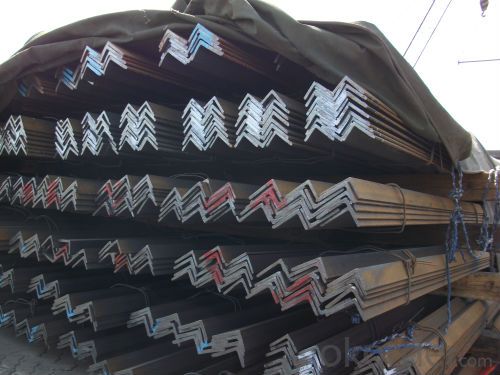
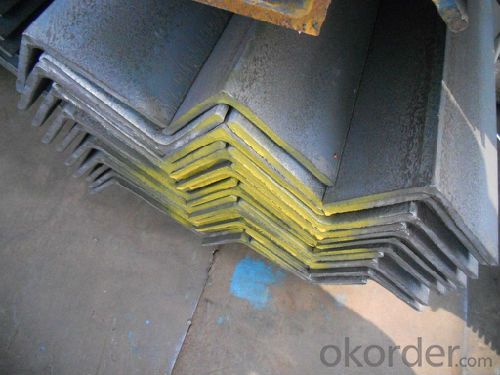
- Q: How do you connect two steel angles together?
- One common method to connect two steel angles together is through welding. Welding is the process of melting the edges of the angles and fusing them together using an electric arc or flame. This creates a strong and permanent connection between the two angles. Prior to welding, it is important to prepare the surfaces by cleaning them from any contaminants or rust. Additionally, aligning the angles properly and securing them in place with clamps or tack welds helps to ensure a precise and accurate connection. Another option to connect steel angles is through the use of bolts or screws. This method involves drilling holes through the angles and then using nuts and bolts or screws to fasten them together. It is crucial to select appropriate fasteners and ensure they are tightened securely to achieve a strong connection.
- Q: How do you protect steel angles from moisture?
- To protect steel angles from moisture, there are several steps you can take: 1. Apply a protective coating: One of the most effective methods is to apply a protective coating such as paint or primer to the steel angles. This creates a barrier between the steel and moisture, preventing direct contact and potential corrosion. 2. Use galvanization: Galvanizing steel angles involves coating them with a layer of zinc, which provides excellent protection against moisture. This process creates a sacrificial layer that corrodes before the steel, thereby extending its lifespan. 3. Implement proper drainage: Ensure that water does not accumulate around the steel angles by providing adequate drainage systems. This can be achieved by installing gutters, downspouts, or using sloping surfaces to prevent water from pooling and causing prolonged exposure to moisture. 4. Regular inspection and maintenance: Regularly inspect the steel angles for signs of moisture buildup, rust, or damage. Promptly address any issues by cleaning, repairing, or applying additional protective coatings to prevent moisture from seeping in. 5. Consider moisture-absorbing materials: Use moisture-absorbing materials such as desiccants or silica gel packs in the vicinity of steel angles to help reduce humidity levels and prevent moisture buildup. 6. Control humidity levels: If the steel angles are located in an enclosed space, ensure proper ventilation and control humidity levels. Using dehumidifiers or fans can help reduce moisture and prevent condensation from forming on the steel surfaces. By following these preventive measures, you can effectively protect steel angles from moisture, prolonging their lifespan and preventing corrosion.
- Q: Can steel angles be used for sound barriers?
- Yes, steel angles can be used for sound barriers. Steel angles are commonly used in construction and can be suitable for sound barrier applications due to their durability, strength, and ability to absorb and block sound.
- Q: Are steel angles suitable for mezzanine floor construction?
- Yes, steel angles are suitable for mezzanine floor construction. Steel angles provide structural support and stability, making them a popular choice for building mezzanine floors. They are strong, durable, and can withstand heavy loads, making them an ideal choice for creating additional floor space in industrial or commercial settings.
- Q: Are steel angles available in non-standard dimensions?
- Yes, steel angles are available in non-standard dimensions. While standard steel angles are typically produced in specific sizes, such as 2x2 inches or 3x3 inches, there are manufacturers and suppliers who can produce steel angles in custom sizes to meet specific project requirements. These non-standard dimensions could include different leg lengths, thicknesses, or overall dimensions that are not commonly found in standard steel angles. Custom steel angles can be fabricated through processes such as cutting, bending, and welding to achieve the desired dimensions. However, it is important to note that non-standard dimensions may require additional time and cost for production compared to readily available standard sizes.
- Q: How do you connect steel angles to other structural members?
- Steel angles can be connected to other structural members through various methods, such as welding, bolting, or using connector plates.
- Q: What are the different test methods used to evaluate steel angles?
- To ensure the quality and suitability of steel angles for different applications, multiple test methods are employed. These methods encompass: 1. Tensile Test: Assessing tensile strength, yield strength, and elongation, this test applies an increasing load to a specimen until it breaks. It gauges the material's ability to withstand forces without deformation or fracture. 2. Bend Test: Evaluating flexibility and ductility, this test bends a specimen to a specific angle, examining it for signs of cracking, fracture, or deformation. Its purpose is to determine the angles' structural integrity when subjected to bending forces. 3. Charpy Impact Test: Measuring impact resistance and toughness, this test subjects a notched specimen to a high-velocity impact. The energy absorbed during impact reveals the material's ability to withstand sudden loads or shocks. 4. Hardness Test: Determining resistance to indentation or scratching, this test employs various methods like Rockwell, Brinell, or Vickers to evaluate hardness properties. It aids in assessing durability and wear resistance. 5. Ultrasonic Testing: This non-destructive method uses high-frequency sound waves to detect internal flaws or defects within the steel angles. It identifies cracks, voids, or inclusions that may compromise structural integrity. 6. Dimensional Inspection: Measuring dimensions, tolerances, and geometric properties, this test ensures compliance with required specifications. It provides accurate information for engineering calculations and fabrication processes. By utilizing these diverse test methods, manufacturers, engineers, and quality control personnel can thoroughly evaluate the mechanical properties, structural integrity, and overall quality of steel angles, thus ensuring their suitability for specific applications.
- Q: What is the maximum deflection for a steel angle beam?
- The maximum deflection of a steel angle beam is influenced by several factors, including the span length, applied load, and the properties of the beam itself. To ascertain the maximum deflection, it is necessary to take into account the beam's moment of inertia, elastic modulus, and the applied load. By employing suitable formulas and calculations, engineers are able to accurately calculate the precise maximum deflection for a steel angle beam in a specific situation. It is crucial to highlight that the maximum deflection should always fall within acceptable limits to guarantee the structural integrity and safety of the beam.
- Q: What are the disadvantages of using steel angles?
- Some disadvantages of using steel angles include their susceptibility to corrosion and rust, limited design options due to their fixed angle shape, and their heaviness which can make them difficult to handle and install. Additionally, steel angles may require additional reinforcement and support to prevent bending or twisting under heavy loads.
- Q: What are the safety precautions when working with steel angles?
- When working with steel angles, it is important to follow certain safety precautions to minimize the risk of accidents and injuries. Here are some key safety measures to consider: 1. Personal Protective Equipment (PPE): Always wear appropriate PPE, such as safety glasses, gloves, steel-toed boots, and a hard hat. PPE will protect you from potential hazards like flying debris, sharp edges, and falling objects. 2. Proper Handling: Use mechanical aids, such as cranes or forklifts, to lift and move heavy steel angles. Avoid manual lifting if the weight exceeds your capacity. Ensure the angles are stacked securely and avoid overloading shelves or racks. 3. Work Area Organization: Keep the work area clean and organized to prevent trips, falls, and accidents. Remove any obstructions or clutter that may hinder movement or cause accidents. Clearly mark areas where steel angles are stored or being worked on to prevent unauthorized access. 4. Inspect Tools and Equipment: Regularly inspect and maintain tools and equipment used to work with steel angles. Ensure they are in good working condition, and if any defects are noticed, repair or replace them promptly. Avoid using damaged or faulty equipment. 5. Cutting and Grinding: When cutting or grinding steel angles, always wear appropriate eye and face protection to shield against sparks, dust, and debris. Utilize tools specifically designed for cutting and grinding steel. Ensure proper ventilation in enclosed spaces to minimize the risk of inhaling toxic fumes. 6. Proper Storage: Store steel angles in a designated area where they are not at risk of falling or causing accidents. Use racks or shelves that are suitable for supporting the weight and size of the angles. Securely stack and strap them to prevent them from toppling over. 7. Fire Safety: Steel angles can generate sparks when being cut or welded. Ensure that there are proper fire prevention measures in place, such as fire extinguishers and fire-resistant materials nearby. Keep flammable substances away from the work area. 8. Training and Awareness: Provide appropriate training to all workers involved in handling steel angles. Ensure they have a thorough understanding of the safety precautions, procedures, and emergency protocols. Encourage open communication and the reporting of any safety concerns or incidents. By adhering to these safety precautions, you can minimize the risk of accidents and create a safer working environment when handling steel angles. Always prioritize your safety and the safety of others while working with steel angles.
Send your message to us
Hot Rolled Steel Unequal Angle Bars
- Loading Port:
- Tianjin
- Payment Terms:
- TT or LC
- Min Order Qty:
- 100 m.t.
- Supply Capability:
- 20000 m.t./month
OKorder Service Pledge
OKorder Financial Service
Similar products
Hot products
Hot Searches
Related keywords
